A Short Intro: Deserts of the World (and why you should give a damn)
Hello Steemit friends! This is my third post about the natural ecosystems of our planet. This topic is all about deserts. While many people would just dismiss deserts as barren lands, they are part of our planet. And they have ecosystem services that they fulfill too. Read on to know more! :D (note: though technically deserts too, I have excluded deserts in the polar regions).
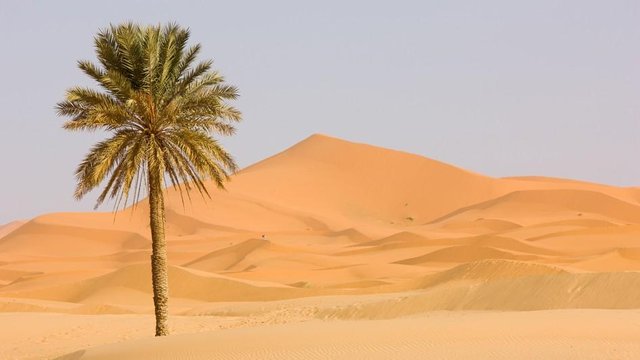
The desert. (image source: http://kids.nationalgeographic.com/explore/nature/habitats/desert/)
Desert ecosystems are known to be notoriously harsh and unforgiving environment for living organisms. Yet even in such seemingly barren and unfavorable landscape, many living organisms thrive. In the Sahara desert alone, where rainfall in some areas occur only in terms of decades, there is around 1,200 plants species despite it being considered “floristically poor” - even by desert standards (Le Houérou, 1986). Living organisms living in the desert manifest some of the most remarkable life strategies and adaptations in order to survive and thrive. Like other organisms in other ecosystems, they show an intimate interaction with the environment they live in. Simply, they showcase life’s resilience and grandeur. It is no surprise that most scientists hoping to find life in other planets come to the desert in order to observe Life’s possibilities.
Desert formation 101
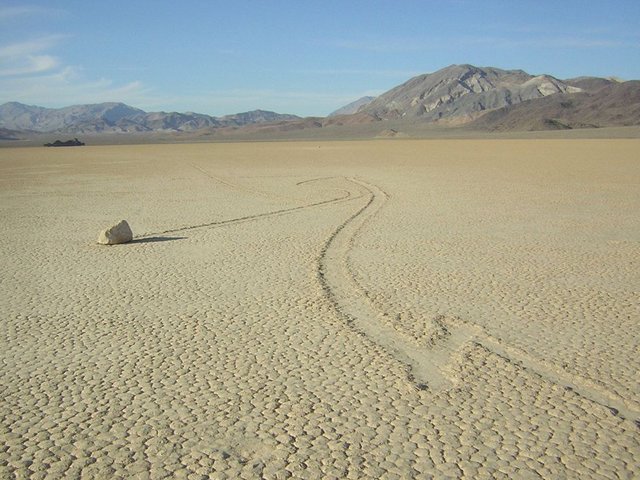
Moving stones, anyone? (image source: https://www.nationalgeographic.org/encyclopedia/desert/)
The location of the hot deserts and arid areas of the Earth is quite varied, but most are primarily located in the regions under the Tropics of Cancer and Capricorn. They are situated in areas where the average annual precipitation falls below 250mm. However, deserts could also be found in areas that have annual precipitation as high as 500mm especially if rainfall occurrence is highly irregular, and with considerable dry periods in between. There are four major categories of large desert of the world as categorized by Cloudsley-Thompson (1977): (1) the sub-tropical deserts; (2) the cool, coastal deserts; (3) the rain-shadow deserts; and (4) the interior continental deserts.
The sub-tropical deserts are located in the Tropics of Cancer, 30 degrees N latitude, and Capricorn, 30 degrees S latitude and is formed primarily due to its location – where the air from the Inter-Tropical Convergence Zone (ITCZ) is typically carried up and consequently forms high pressure cells, and warms up as it descends. This phenomenon leads to the kind of oppressive air temperature commonly observed in deserts such as the Sahara. Conversely, the cool, coastal deserts is where the effects of the descending high pressure dry air is intensified due to the proximity of cold ocean currents. The presence of such cold currents, however, brings cool, moist winds from the ocean and fog in the vicinity areas after daylight periods (e.g. Namid and Acatama Deserts). The rain-shadow deserts are formed due to the presence of topographical barriers (like mountain ranges) which interrupt the flow of the cool, and moist, oceanic winds. This causes orographic precipitation on the windward slope (~the side of the mountain facing the ocean), which in turn causes the air to lose its moisture and warm up due to compression heating as it makes way on the leeway slope (~the side of the mountain facing away from the ocean) (e.g. Mojave Desert). While the interior continental deserts are formed primarily due to their distance from the ocean; far from any adequate source of cool, moist winds (e.g. part of the Great Australian Desert) (Cloudsley-Thompson, 1977; Louw and Seely, 1982; Stiling, 1996; Osborne, 2012). I suggest further reading on this one to get a more detailed picture.^^
Liebig’s Law
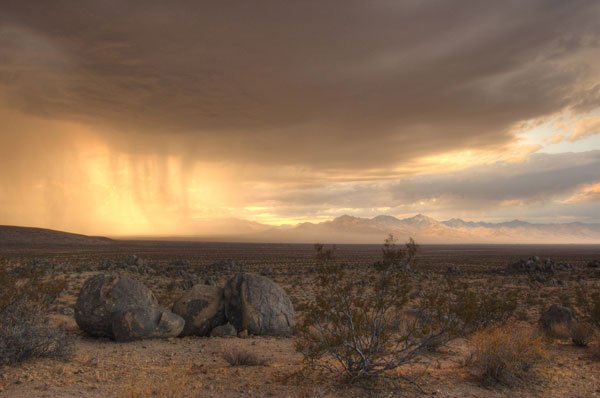
It rains in deserts too, but don't wait for it! (image source: https://drewcuster.wordpress.com/2012/05/16/567/)
Due to the erratic seasonality and meager distribution of rainfall in deserts, all desert organisms must cope up with this underlying condition. Being arid, the obvious limiting resource in a given desert ecosystem is water. I have been sharing about “limiting factor” ever since my first ecosystem write up (re: Rainforests) but have overlooked to explain such important concept, so here it is. The occurrence of limiting environmental factor was first described by Justus Liebig in 1940 when he noticed the restrictive effect of an environmental condition to the growth of a plant. The said observation and subsequent experiments, eventually paved way to the concept of Liebig’s Law which states that: under a steady state, an essential substance occurring in minimal quantity in relation to the needs of a population will regulate the development of the said population. A limiting factor cannot be assumed based on its amount, no matter how small, but should rather be based on the organism’s (or population’s) requirement in general. When environmental changes occur or the supply of the given limiting resource is enhanced, it may stay the same, or a new one will arise. Thus, in a way, you could view the natural ecosystems as a reflection of the limiting resource a particular area has. In the case of water as a limiting resource in a desert ecosystem, Seely and Louw (1980) demonstrated that the marked increase in plant biomass in the Namib Desert after rainfall shows the importance of water - and its limiting capacity.
The glaring influence of temperature
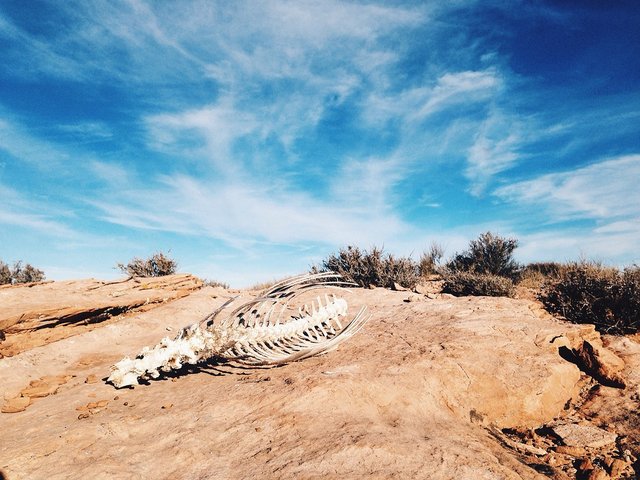
Image source: https://pixabay.com/en/desert-dry-landscape-nature-hot-1246842/
All creatures of the Earth live and reproduce in certain temperature range they are adapted to. These temperature ranges vary quite exquisitely and some species do live in some extreme conditions and temperature that the environment has. Some microorganisms, for example, can survive and thrive in hot springs that have blistering temperatures near 100°C, while other organisms can do just the same in the opposite situation in their habitats with very low temperatures.
Desert plants must continually adapt to the temperature in their environment as they cannot move away from heat stress, especially in the case of perennial desert plants. This is particularly challenging in such environment as the desert where extreme high temperature is common and water is scarce. To minimize the effect of heat stress, desert plants have covering in their leaves and stems such as white hairs or have generally lighter shades of green colorations in order to reduce heat absorption and reflect light more efficiently, respectively. In addition, desert plants the angle of their leaves to further reduce water loss and avoid heat uptake. These strategies might also be more directed for a more efficient photosynthetic rate and water absorption during periods of relative high humidity, especially in the morning (Gibson, 1998; Osborne, 2012).
Desert animals, on the other hand, have developed different anatomical, physiological and behavioral adaptations in order to combat heat stress. They show a great deal of different strategies; from the nocturnal behavior of most insects, to the bimodal activity of the sand-diving lizard (Aporosaura anchietae), all in order to adapt to the extreme temperatures of their environment (Louw and Seely, 1982; Osborne, 2012).
The tenacity of Life
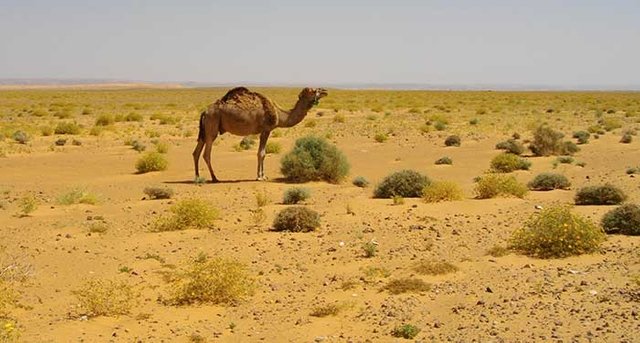
The camel and its habitat. (image source: https://www.desertusa.com/du_sahara_life.html)
All living organisms in the desert mainly strategize in overcoming water deficiency, temperature fluctuations, and other environmental factors brought about by the desert. Most desert organisms specialize in diapause strategy, in which they survive using little water and other necessary resource during the dry periods, and then have exponential growth rate and reproduction when rainfall arrives. Desert organisms exhibit extraordinary capability in maximizing water retention in their bodies, high tolerance in dehydration as well as the ability to bounce back from such conditions when resources become available, and environmental conditions become more favorable (Cloudsley-Thompson, 1991; Osborne, 2012).
Aside from diapause, desert animals also develop more extreme strategies for survival, such as in the case of the non-biting midge, Polypedilum venderplnki, which utilize cryptobiosis. Cryptobiosis, unlike diapause and other similar survival strategies, enables an organism to survive even under complete desiccation up to the cellular level, with complete cessation of metabolism. Cryptobiotic organisms can also enter their dormant phase whenever needed, compared to diapause which is irreversible. The larva of Polypedilum venderplnki digs in the soil during dry season and completely rehydrates when rainfall occurs and then continue its life stages until pupation and adulthood. Some plants also exhibit cryptobiosis (Cloudsley-Thompson, 1994; Belk and Cole, 1975). Another strategy by desert animals for survival is aestivation, which is quite like hibernation. The main difference being the environmental conditions they are employed (Osborne, 2012).
It is also about the soil
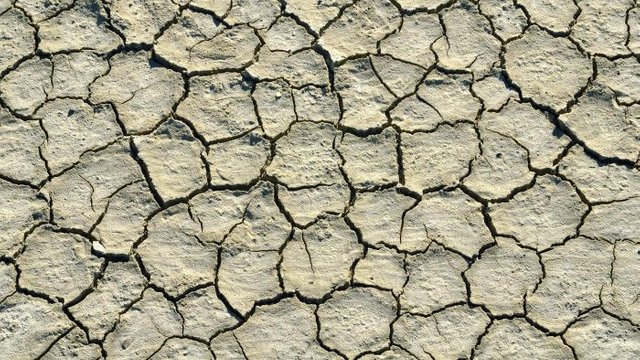
Image source: https://www.reference.com/science/kind-soil-desert-56da5a71d963b557
At a glance, one may observe that the underlying environmental conditions in the desert have the most influence for the various life strategies of the organisms dwelling on its landscapes. However, most the effects set upon by these conditions can either be minimized or maximized by the soil. Water is scarce in desert areas, but its effect is magnified by the increased salinity of the soil. The relatively quick evaporation of water on the desert soil surface leaves trace amounts of salts in its surface. Over time, this process will increase soil salinity, especially in the surface. This would prevent for water to percolate (~seep in) even after a strong rain, making it harder to keep the soil moist. The desert soils’ predominant sandy composition, coupled with its low organic matter, makes it to have a low field capacity (~low water retention rate). And thus leads to the relatively barren desert landscape we are familiar with (Noy-Meir, 1974; Osborne, 2012).
Desertification is land degradation
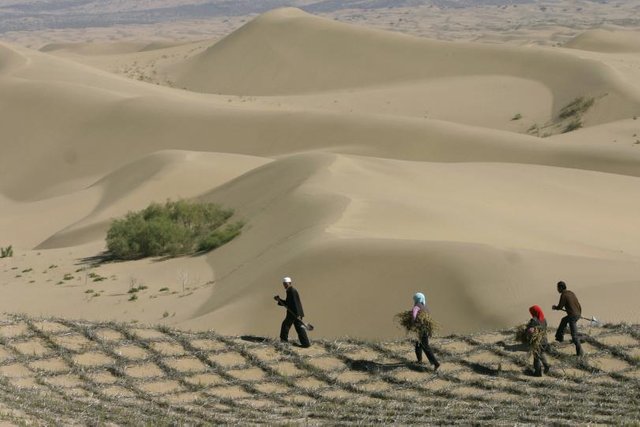
The desert is not just a mere open space of land. (image source: http://www.ibtimes.com/land-degradation-desertification-might-create-50-million-climate-refugees-within-2097242 / ©Reuters/Stringer)
There are no sufficient evidence to support that desertification, as a natural process, is responsible for the expansion of the major deserts of the world. In 1999, Tucker and Nicholson found out that the Sahara desert’s boundary expands and contracts mainly due to year-to-year precipitation variations. Desertification is likely to be enhanced by human activities, and can be regarded as a type of land degradation. The increased rate in change of land use by humans has had a high impact in most ecosystems of the Earth. The desert ecosystems of the world are not exempted from this. The five major countries in North Africa (~Algeria, Egypt, Libya, Morocco, and Tunisia) that covers the Sahara desert, for example, has had a staggering increase in population from just 8 million a hundred years ago, to more than 150 million as of 2012 - with an estimated growth rate of more than 2.5% annually. The resources they need - mainly coming from the desert - puts enormous pressure on the desert and outlying arid ecosystems (Osborne, 2012).
Through better land management, these impacts may still be reversed but it would be a daunting task to achieve. The desert ecosystem has many benefits, and just like any other ecosystems, they must be conserved. Ward (2009) have argued that: 1) deserts provide an avenue for the study of adaptations and evolution to arid environments; 2) desert organisms and their habitats are unique and special; 3) desert habitats provide ecological benefits, and 4) many deserts are relatively pristine, and have not been affected by human activities.
References:
Belk, D. and Cole, G.A. (1975). Adaptational biology of desert temporary-pond inhabitants. In: Hadley, N.F. (ed.), Environmental physiology of desert organisms, pp. 207-226. Stroudsbury: Dowden, Hutchinson and Ross.
Cloudsley-Thompson, J.L. (1977). Man and the biology of arid zones. London: Edward Arnold.
Cloudsley-Thompson, J.L. (1991). Ecophysiology of desert arthropods and reptiles. Berlin: Springer Verlag.
Cloudsley-Thompson, J.L. (1994). The Sahara Desert – life without water. Biologist 41: 72-75.
Gibson, A.C. (1998). Photosynthetic organs of desert plants. BioScience 48: 911-920.
Le Houérou H.N. (1986). The desert and arid zones of northern Africa. In: Evenari, M., Noy-Mier, I. and Goodall, D.W. (eds), Hot deserts and arid shrublands, Ecosystems of the world 12B, pp. 101-147. Amsterdam: Elsevier.
Liebig, J. (1940). Chemistry in its application to agriculture and physiology. London: Taylor and Walton.
Louw, G. and Seely, M. (1982). Ecology of desert organisms. London: Longman.
Osborne, P.L. (2012). Tropical ecosystems and ecological concepts. 2nd edn. New York: Cambridge University Press.
Noy-Meir, I. (1974). Desert ecosystems: higher trophic levels. Annual Review of Ecology, Evolution, and Systematics 5: 195-213.
Seely, M.K. and Louw, G.N. (1980). First approximation of the effects of rainfall on the ecology and energetics of a Namib Desert dune system. Journal of arid environments 3: 25-54.
Stiling, P.D. (1996). Ecology: theories and applications. 2nd edn. Upper Saddle River: Prentice Hall.
Tucker, C.J. and Nicholson, S.E. (1999). Variations in the size of the Sahara Desert from 1980 to 1997. Ambio 28: 587-591.
Ward, D. (2009). The biology of deserts. Oxford: Oxford University Press.
Learn more about other ecosystems:


to me this sounds like a scientific article. And these nice pictures from national geographic. When you visit berndsenf.de and desert-greening.com you will find out ( if you are scientifically minded), that it is 11.9% of the facts. Find out the rest by yourself, even if it takes several month.
In a way it is a scientific article, but not quite. This is a basic synthesis write-up attempting to introduce the basic ecological processes of the desert ecosystem. I have actually excluded some ecolological concepts that were too technical from my reference materials. My main objective is to pique the interest of anyone who reads this post, and hopefully they could further research on their own. And yes, my first two photos were actually from National Geographic.
Thank you for sharing the links. I will make sure read them on my own time. Cheers to science!😊
Wow, it's a real scientific article, but I managed to go through a good fraction of it. You seem to really be an expert in this area. I enjoy studying complex systems, and seeing what emerges from them. One thing I find interesting is this Liebig’s Law. I was thinking it might apply to human sociology to... Limit the resources, limit the growth of the population... But does it take into account the adaptability of a species in finding an alternative ? ;-).
Thank you for your kind words, though my write-up is just a simple synthesis. It's not even a formal one. A lot of the complex ecological concepts in the environment can actually be explained through physics and chemistry, so I think you'll do well in this field.😊
I think when it comes to the human population, the clash is between Malthusian/Neo-Malthusian point of view vs Curnocopian/Neo-Curnocopian point of view when it comes to resources. Liebig's Law is strictly for resources directly responsible for an organism's growth. But yes, I think some parts of its concept could be adapted to sociology.😇
EDIT: Yes, a species' adaptability to find an alternative resource is also taken into account. Such phenomenon sometimes leads to increased speciation.
You are really sn expert in ecosystem. I enjoy your post which is full of information though little lengthy
Thank you for your kind words @hafiz34. I'm not really an expert in ecosystem dynamics, the ecological concepts discussed above (as well as for my other ecosystems posts) are baseline knowledge that any budding environmental scientist should know. I consider myself as a novice scientist and researcher, but not really an expert.😇
Resteemed to over 5300 followers and 100% upvoted. Thank you for using my service!
Send 0.100 Steem or 0.100 Steem Dollar and the URL in the memo to use the bot.
Read here how the bot from Berlin works.
@resteem.bot
Congratulations @dean101! You have completed some achievement on Steemit and have been rewarded with new badge(s) :
Click on any badge to view your own Board of Honor on SteemitBoard.
For more information about SteemitBoard, click here
If you no longer want to receive notifications, reply to this comment with the word
STOPThanks! :>
Very informative!
#cof
Thank you Chief!^^
#cof
Really good :) thanks for sharing (:
Thank you for your kind words @best-trip-eva!😊 Glad you liked it.
Informative. Learned more about the deserts. :)
Glad you liked it. Thank you for dropping by @zararina!😀😇
As a follower of @followforupvotes this post has been randomly selected and upvoted! Enjoy your upvote and have a great day!
Thanks! :>